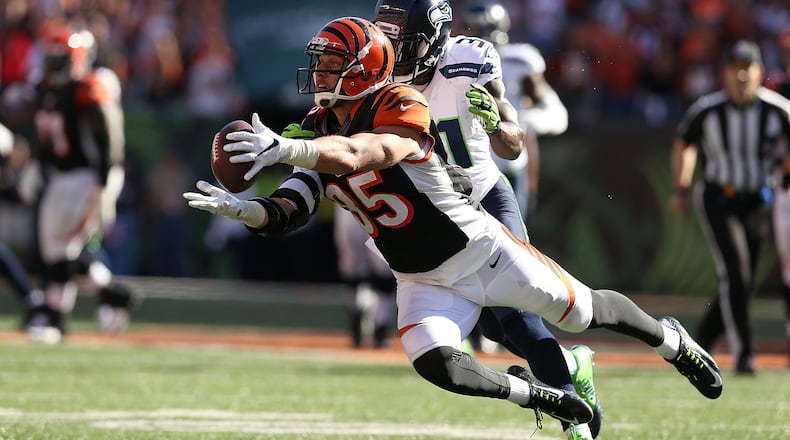»RELATED: Bengals not making snap decisions despite Price’s struggles
Both rules needed a little clarity, but especially the new helmet rules designed to prevent players from lowering their head to initiate contact.
“It is a mystery, but we’ve seen some good examples of it,” Cheffers said. “Coaches have seen some good examples of it throughout the offseason of what type of hit we’re trying to get out of the game. Certainly preseason is always a little bit of a proving ground. I’m sure we’ll throw some flags that maybe don’t prove out, and we’ll maybe miss some things they want and we will probably call a lot of stuff they want as well. We’ll end up with a good library of plays we can then show to the teams and say this is what we want, this is what we don’t want. That will obviously benefit us as well. Once we get to the regular season our intention would be that we’ll all be in step with the type of action we don’t want and what type of action is going to be legal.”
»RELATED: Bengals counting on big production from hometown linebacker
The helmet rule is intended to help cut down on significant injuries that occurs with aligning the head, neck and spine when going in for a tackle, block or hit on an opponent. All 22 players on the field can be flagged on the helmet rule.
Cheffers said “initiating” is the key word in deciphering the rule, but even that isn’t as easy to pinpoint as it might sound.
A defender holding his position and bracing for contact is not in violation of the rule because he’s not initiating contact. However, if a defender drops his head to the side to avoid contact but a receiver adjusts and gets hit by the opponent’s helmet, the defender can be called for a foul.
“Sometimes it’s unfortunate if the receiver makes a move and puts them in a bad spot but the interpretation of the rule is very consistent that it’s on the defender to make sure his contact is legal,” Cheffers said.
»RELATED: Bengals who were Buckeyes weigh in on Urban Meyer
The catch rule is a little less tricky in that it is now defined by three components: Control of the ball, two feet on the ground (or another body part) and a football move (or the ability to make one).
A receiver no longer has to maintain control upon hitting the ground for the pass to be complete. If the receiver has completed the three-step process of the catch and breaks the plane of the goal line, it is a touchdown regardless of whether he loses control upon hitting the ground.
“Going to the ground was a component last year and this year it wasn’t,” Cheffers said. “We’re taking two seconds out of that play and saying he completed the process of the catch because he controlled the ball, his knee hit the ground and he turned and reached out to cross the goal line. Now he already broke the plane so it’s a touchdown and if he hits the ground it doesn’t matter.”
»RELATED: Bengals players react to release of veteran and youth movement it signals
On the flip side, the receiver is considered a runner after making a catch, so if he loses the ball before getting hit or breaking the plane of the goal line, that’s a fumble.
Defenseless player rules still apply.
“We’ll probably have a few more of those (fumble calls) this year than last year, that would be my guess because before we called that incomplete, but now that play without contact could easily be a fumble,” Cheffers said. “If he completes the three components (of the catch), … anything that can happen to a runner can happen to him except that little piece of defenseless player protection he gets.”
There will always be gray areas, but Cheffers said if officials have doubts, they will not call it. The league has other ways of dealing with missed fouls, such as through fines and other disciplinary action if necessary.
Cheffers is confident players will adjust to the rules, as they continue to evolve each year.
“In my 19 years in this league, players do a very good job of adapting to new rules as they evolve so I fully expect they will adapt,” Cheffers said. “(With the helmet rule) it’s as much for the hitter’s safety as the hittee’s safety on these things, so it’s really important that we modify our technique and get those kinds of hits out. They usually evolve very quickly to make sure they are performing to the rules.”
About the Author
